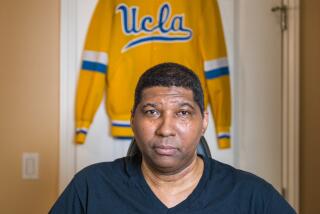Steeled for a Future in Basketball
- Share via
CLARKSVILLE, Tenn. — Hours after breaking Austin Peay University’s all-time basketball scoring record Jan. 23 with a 40-point concerto against Middle Tennessee, senior forward Bubba Wells plopped down on the coach’s couch and wondered what the fuss was about.
The fact that he has become the nation’s unofficial leader in scoring average on legs held together by steel-rod implants seemed beside the point, so to speak.
“People asked me, ‘Do you think [the rods] will mess your shot up?’ ” Wells said. “I didn’t have surgery on my wrist, or my eyes. I had it on my legs.”
Strangely susceptible to stress fractures, Wells has had two 16-inch stainless steel rods inserted from his knees lengthwise into his shinbones, which had been hollowed out with a drill to make room for them.
In the process, he has become one of the remarkable stories of collegiate athletics this year--basketball’s real “Rodman”--wowing pro scouts and becoming a cult figure in this city of 80,000.
Fifty days after his last surgery, college basketball’s man of steel emerged from a phone booth to resume a career as the best player to lace up at Austin Peay since James “Fly” Williams in the early ‘70s.
He had missed the season’s first 12 games. But on Jan. 4, Wells came off the bench against Southeast Missouri and scored 39 points in 28 minutes, making seven of 11 three-point attempts.
The home crowd was stunned.
“One would have thought Elvis Presley had risen from the dead,” Clarksville Leaf-Chronicle columnist Larry Schmidt wrote.
Austin Peay Coach Dave Loos still can’t believe what he saw.
“He was only out 50 days,” Loos said. “It’s to the point where I’m continually impressed by what he does, but no longer surprised.”
In 13 games since returning this season, Wells is averaging 30.7 points. He has scored 30 or more points seven times.
Wells credits his comeback to the operations, called tibial nailings, one performed late in the 1995 season and the second on Nov. 20. They went off without a hitch. Almost.
During the second operation, to reinforce a stress fracture in Wells’ left leg, the surgeon, Cooper Beazley, held the nail at the top of Wells’ tibia, or shinbone, while his assistant gripped the stainless steel sledgehammer, took dead-eye aim and . . .
. . . smacked Beazley.
“That didn’t feel too good,” Beazley recalled of the Moe-Curly exchange. “Ever been hit on the hand with a five-pound hammer?”
And it wasn’t even the first mishap. Surgery had begun ominously when Beazley broke his $9,000 air-powered drill trying to bore into Wells’ bone.
Beazley asked his scrub nurse if the drill could be salvaged. She told him to trash it.
“It was like trying to drill through a concrete wall,” Beazley said of Wells’ bone.
Left Leg Gives Way
It took Wells six months to recover from his first “rodding,” also performed by Beazley after Wells had broken his right lower leg during the 1995 Ohio Valley Conference title game.
Wells returned from that operation to become the nation’s third-leading scorer last season, averaging 26.3 points a game.
Then, in an exhibition game last fall, he felt his left leg give way.
Joni Johnson, Austin Peay’s trainer, suspects Wells had injured the leg earlier but didn’t want to admit it for fear of missing play. “The first time he saw me, I sat him out six months,” she said. That was the summer before Wells’ freshman year, in 1992, when he was found to have a stress fracture of his right leg and was not allowed to play for a season.
When Wells finally confided in Johnson this time, a bone scan was done and the worst fears were confirmed.
“I thought there was no way this would happen twice to the same guy,” Loos said. “He came that morning and told me, just sat down here with a tear in his eye and said ‘I’ve got another one.’ I thought he was kidding me.”
Senior Season at Stake
A teammate suggested that Wells might have to give up basketball.
“I can’t do that,” Wells told him. “I don’t know what I’d do if I couldn’t play basketball.”
Wells wanted the left leg “rodded” immediately.
With his senior season at stake, and pro scouts keeping up with developments, Wells started rehabilitating the leg with Johnson the day after surgery.
Wells marked the occasion by getting a tattoo on his right arm that read “Man of Steel.”
Beazley has performed “rodding” procedures for 15 years, mostly on trauma patients. The surgery has become more common in athletes in recent years, but Beazley could not recall an athlete undergoing a double rodding.
The operation takes about two hours. “It’s like if you took a straw and broke it, and you put a pipe on the inside and put it back together again,” Beazley explained. The rods prevent the stress fracture in the tibia from becoming a full break.
Wells says his legs are relatively pain-free. There remains some soft-tissue tenderness from the surgery and, once in a while, he can feel the screws that were inserted near his kneecaps to hold the rods in place.
“I was afraid at first that something would go wrong,” he said. “But it hardly gave me any problems.”
The rods have not affected his play. In fact, his statistics have improved after each surgery.
Wells’ scoring average rose from 19.3 points his sophomore season to 26.3 as a junior.
Unofficially Wells is leading the nation in scoring average, but he won’t win the title because he cannot play in 75% of his team’s games, as required.
The 40 points he scored against Middle Tennessee, breaking Tom Morgan’s 40-year-old record for a career, nearly matched the career-high 42 points he scored last year against Air Force.
No Airport Alarms
The question Wells is asked most?
Easy. Does he set off the metal detectors in airports?
No. At least he didn’t after the first rodding. Just in case, Johnson carried an X-ray of Wells’ right leg on Austin Peay trips last season, and Wells has not had to fly since his second surgery.
Johnson says the risks of Wells playing with the rods are minimal.
“He’s not going to break his tibias unless he has a freak accident, like getting run over by a truck,” she said. “That’s how strong the nails are.”
And she can only marvel at the technology that allowed Wells to pursue his dream. This is not a case of Wells shooting set shots on two bum legs. He has lost little of the athletic ability that has made him a legitimate NBA prospect.
If anything, Wells said, the rehabilitation allowed him to hone his shooting skills.
Twenty years ago, 10 perhaps, Wells’ career would have been over.
“He’d be a rec player, one game a week,” Johnson said.
Johnson speculates that Wells might suffer from calcium deficiency, which could explain the stress fractures, although Beazley says the player’s blood work does not suggest that is the problem.
No one is sure what caused the injuries.
Wells might have been betrayed by his own wishes.
He was 5-feet-5 in the eighth grade, in his horse-country hometown of Russellville, Ky., 37 miles north of Clarksville.
Wells used to come home from school and tell his mother, “I’m never going to grow.”
Then, like the beanstalk in the fable, Wells sprouted. Between his freshman and sophomore years in high school, he grew from 5-8 to 6-1.
He inched to 6-3 as a junior, then grew two more inches his first year at Austin Peay, named after the former Tennessee governor who founded the state university in 1927.
Growth Spurts
Wells had other scholarship offers but wanted to stay close to home.
He says the growth spurts, coupled with the 50 pounds he gained his freshman year, might explain his problems with brittleness.
But they never have detoured him.
“I had a lot of obstacles, but if you love something, you’re going to try to do what you can,” he said.
Now 6-5 and 230 pounds, Wells is a legend at Austin Peay, a school with few basketball highlights. Fly Williams made a national splash in the early ‘70s with his scoring exploits, leading the Governors to the NCAA tournament, and they were back again, in 1987, when they upset Illinois in the opening round, then gave Rick Pitino’s Final Four Providence team all it wanted in a three-point, second-round loss.
“Bubba could run for the mayor of Clarksville and he would win, no question,” said Beazley, Wells’ biggest fan. “People love him. They truly love him.”
Wells has charmed Clarksville with his stellar play, homespun humility and superstitions.
He will chew only “Double Bubble” gum, will not eat chicken on the bone, must pick out the game ball before each game, must wear a sweatband on his left forearm. Last year, in Toledo, Ohio, a team official had to make a last-second dash to a department store after Wells forgot his armband.
The night he broke Morgan’s scoring record, scoring 40, they stopped the game. Wells blew kisses to the crowd of 4,240. Some in the bleachers cried.
During the game, a Middle Tennessee player made the mistake of knocking Wells down.
“I swear,” Beazley said, “I thought people were going to jump out of the stands and beat him up. They were livid.”
Wells started out as an undersized, low-post player who slowly developed an outside game. Now NBA scouts are comparing him to Charles Barkley of the Houston Rockets.
“I see why they think I play like [Barkley],” Wells said. “I can go inside, I can go outside. But he’s got some pounds on me.”
Still, the scouts wonder, is he a shooting guard? A small forward? A power forward? But they don’t wonder about his legs holding him down.
“He’s like the guy in baseball that hits so good, you’ve got to find a place for him to play,” Loos said.
(BEGIN TEXT OF INFOBOX / INFOGRAPHIC)
Rod Man
Because of a problem with stress fractures, doctors inserted steel rods in both legs of basketball player Bubba Wells.
[1] Drill hole in length of bone.
[2] Insert stainless steel rod.
[3] Add locking screw to top.
16” Stainless steel rod with locking screw
More to Read
Go beyond the scoreboard
Get the latest on L.A.'s teams in the daily Sports Report newsletter.
You may occasionally receive promotional content from the Los Angeles Times.











